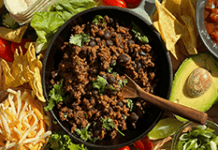As a dietitian and mom to two energetic boys, I know firsthand how important a balanced diet is for our kids’ health. When they hit those teen years, feeding them becomes all about fueling their rapid growth and supporting their mental and physical development. To meet their nutritional needs Canada’s Food Guide suggests a variety of protein sources, including lean meats1.
 Meeting Nutritional Requirements and Overcoming Deficiencies in Teenagers
Meeting Nutritional Requirements and Overcoming Deficiencies in Teenagers
Those teenage years are a whirlwind of growth and changes—not just in height but in their brains and hormones too. Among other nutrients, teenagers need plenty of protein, iron, zinc, and vitamin B12 to keep up. Protein boosts muscle growth and supports hormonal balance and mental sharpness, while iron is key for healthy blood and oxygen flow. Zinc powers the immune system and energy levels, and vitamin B12 is critical for producing red blood cells and maintaining energy1, 2, 3, 4. Including beef in your teen’s diet can be a practical way to supply these vital nutrients, ensuring your kids get what they need to thrive during these transformative years.
Despite this being a time of high nutritional needs, many Canadian teens miss getting all the nutrients they need. Did you know that over half of the daily calories in Canadian kids’ diets come from highly processed foods 2. Not getting adequate nutrients is an especially big issue for teen girls, who often do not get enough vitamins A, D, B6, B12, folate, and minerals like magnesium, zinc, and iron, which can affect everything from their bone health to their ability to focus on school2, 5, 6.
Also, it looks like the standard protein recommendations might be too low for our growing kids. Current guidelines suggest children aged 4–13 require approximately 0.95 grams of protein per kilogram of body weight each day, while teenagers aged 14–18 need about 0.85 grams per kilogram. Yet, recent studies indicate that the actual requirement for children aged 6–10 could be as high as 1.55 grams per kilogram per day7, 8, making the need for protein-rich choices all that more important.
Beef as a Nutrient-Rich Solution
Including beef in your teen’s diet can help meet their nutritional needs effectively. Beef is a popular food and key ingredient for many of the foods kids love, making it an ‘easy sell’ for family meals. Beef offers high-quality protein and is packed with iron, zinc, and vitamin B12, nutrients essential for physical growth and cognitive development during the teenage years 4. It is not just about the meat itself; including meat in meals helps boost the absorption of iron and zinc from veggies and other plant-based foods3, 4. This is particularly important for teenage girls, who often face higher risks of nutritional gaps5.
 In addition, studies have found that teens who regularly include beef in their diet not only get more of the nutrients found in meat, but also tend to have higher overall intake of other important nutrients such as calcium, compared to their peers who eat no beef 5. This suggests that teens eating beef are likely following a well-rounded diet that includes a variety of food groups, which is exactly what Canada’s Food Guide suggests for a nutrient-rich diet1.
In addition, studies have found that teens who regularly include beef in their diet not only get more of the nutrients found in meat, but also tend to have higher overall intake of other important nutrients such as calcium, compared to their peers who eat no beef 5. This suggests that teens eating beef are likely following a well-rounded diet that includes a variety of food groups, which is exactly what Canada’s Food Guide suggests for a nutrient-rich diet1.
Making Beef a Fun Part of Your Teen’s Diet
Beef is incredibly versatile and can be spun into a bunch of tasty and nutritious dishes. From juicy burgers and sizzling steaks to zesty stir-fries and cozy stews, there is so much you can do. Why not pull your teens to work in the kitchen? Cooking together can transform meal prep from a chore into a fun, bonding activity. It is a chance to teach them about nutrition, develop food skills, and help them develop a love for healthy eating.
Practical Tips for Incorporating Beef into Meals
- Think beef for breakfast: Kickstart your teen’s day with protein-packed breakfasts like beef burritos or beef and egg muffin cups. This Cheeseburger Frittata is very easy to make, and with some extra veggies it makes a delicious, balanced breakfast.
- Give them protein at lunch: Prepare beef wraps or sandwiches with whole grain bread, and a side of crunchy veggies. Try Spicy Beef Wraps to Go and Chipotle Spiced Beef Stacked Salad for tasty meals that are not likely to come back home uneaten!
- Balanced dinners: Engage the whole family in cooking dinner, trying out recipes like beef and vegetable kebabs or spaghetti with meat sauce. Or take your burgers to the next level (shown below) with Cuban Picadillo Burger Rice Bowl.
 Nourishing Teens with Nutrient-Rich Beef
Nourishing Teens with Nutrient-Rich Beef
Offering a diet rich in nutrients like high-quality protein, iron, zinc, and vitamin B12 is essential for supporting our teens through their growth spurts and into healthy adulthood. By integrating nutrient-dense foods like beef as part of a balanced diet, we are not just catering to their current needs—we are helping them develop lifelong healthy eating habits1, 5.
References
1 Health Canada. (2022). Healthy eating for teens. Canada’s Food Guide. Retrieved April 5, 2024, from https://food-guide.canada.ca/en/tips-for-healthy-eating/teens/
2 Ng, A. P., Ahmed, M., & L’Abbé, M. R. (2021). Nutrient intakes of Canadian children and adolescents: Results from the Canadian Community Health Survey (CCHS) 2015 – Nutrition Public Use Microdata Files. Retrieved April 5, 2024, from 5bdc1f29-bcf0-4066-9838-9682378a295a.pdf (researchsquare.com)
3 Cooper, M. J., Cockell, K. A., & L’Abbé, M. R. (2006). The iron status of Canadian adolescents and adults: Current knowledge and practical implications. Canadian Journal of Dietetic Practice and Research, 67(3), 130–138. Retrieved April 5, 2024, from https://dcjournal.ca/doi/abs/10.3148/67.3.2006.130
4 An, R., Nickols-Richardson, S. M., Khan, N., Liu, J., Liu, R., & Clarke, C. (2019). Impact of Beef and Beef Product Intake on Cognition in Children and Young Adults: A Systematic Review. Nutrients, 11(8), 1775. Retrieved April 5, 2024, from: https://www.mdpi.com/2072-6643/11/8/1797
5 Fulgoni, K., & Fulgoni, V. L. (2023). Beef intake is associated with higher nutrient intake and nutrient adequacy in U.S. adolescents, NHANES 2001–2018. Nutrients, 15(23), 4996. Retrieved April 5, 2024, from https://www.mdpi.com/2072-6643/15/23/4996
6 Health Canada. (2012). Do Canadian Adolescents Meet Their Nutrient Requirements Through Food Intake Alone? Retrieved April 5, 2024, from https://www.canada.ca/content/dam/hc-sc/migration/hc-sc/fn-an/alt_formats/pdf/surveill/nutrition/commun/art-nutr-adol-eng.pdf
7 Health Canada. (2023). Dietary reference intakes: Reference values for macronutrients. Retrieved April 5, 2024, from https://www.canada.ca/en/health-canada/services/food-nutrition/healthy-eating/dietary-reference-intakes/tables/reference-values-macronutrients.html
8 Hudson, J. L., Baum, J. I., Diaz, E. C., & Børsheim, E. (2021). Dietary Protein Requirements in Children: Methods for Consideration. Nutrients, 13(5), 1554. Retrieved April 5, 2024, from https://www.mdpi.com/2072-6643/13/5/1554

Hana Klimczak is a Toronto-based registered dietitian and mother of two, passionate about providing simple and nutritious meal solutions to busy parents. Follow Hana on Instagram for family-friendly recipes and inspiring nutrition tips!
April 2024





